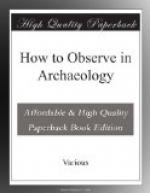Saites, XXVI-XXX Dynasties, 664-342 B.C. Pottery clumsy, mostly rough: some thin, smooth red. Greek influence; silver coins from 500 onward. Iron tools beginning. Glaze pale greyish and olive: some fine blue at 350. No glass. Bronze figures common. Ushabtis with back pier and beard; fine 650 to poor at 350.
Ptolemies, 332-30 B.C. Pottery clumsy and small. Many Rhodian jars with Greek stamped handles. Glazes, dark violet and yellow-green. Glass revived for inlay figures in shrines: minute mosaic begins. Glazed beads scarce, no scarabs. Large copper coins, silver tetradrachms, base in later time, and concave on reverse.
Romans, 30 B.C.-A.D. 641. The earlier half, to A.D. 300. Large brown amphorae, peg bottoms; ribbed after 180, wide ribbing at first, then narrower. Glass blown; fine white and cut facets in 1st cent.; hollow brims 2nd-4th; stems and pressed feet, 3rd-4th. Glass mosaic 1st cent.; coarser wall mosaic 2nd cent. Glaze coarse blue, on thick clumsy bowls and jugs. Red brick buildings as well as mud brick, coins: billon tetradrachms in 1st cent., almost copper in 2nd, small copper dumps in 3rd, leaden tokens from A.D. 180 to 260. Some large copper in 1st and 2nd, thinner than the Ptolemaic. Potsherds used for writing receipts and letters. Abundance of moulded terra-cottas, and small lamps.
Roman, Second Period, A.D. 300-641. The Constantinian Age brings in new styles. Much salmon-coloured hard pottery, mainly platters and flat dishes. Brown amphorae soft and smaller, with narrow ribbing. No glaze. Much very thin glass. Coins: little thin flat copper, as in rest of Empire, ending about 450. No Egyptian coinage, except a very few rough lumps from Justinian to Heraclius, I+B on back. Letters written on potsherds and flakes of limestone.
Red brick the material for all large buildings. Limestone capitals of debased leafage. Rudely cut relief patterns in wood. Coarsely carved and turned bone or ivory. Pottery in Byzantine Age with white facing and rudely painted figures. Textiles, with embroidery in colours, and especially purple discs with thread designs of the earlier Arab period. A characteristic of late Roman and Arab mounds is the organic smell.
Muhammadan Period. Seventh to fifteenth centuries. Characterized by great amounts of glazed pottery. Smaller antiquities found in cemeteries or on ruined sites, the earliest transitional, and related to Coptic examples of the same kinds. Pottery: lamps at first continue Christian forms and are unglazed; afterwards long spouted lamps of dark green glaze. Fragments of vessels, &c., from the rubbish heaps of old Cairo are glazed; a typical faience has a soft sandy body of light colour with painted designs in blue or blue and brown with transparent glaze. Those of the Mamluk period, and probably some of earlier date, show a general resemblance to Western Asiatic contemporary wares, due to importation of potters from




